
 |
 |
| HISTORY IMAGE GALLERY CUSTOMERS PUBLISHED ARTICLES |
 A southeast Texas town celebrates 175 years on the Guadalupe Texas Highways, October 1999  ictoria is having a birthday party. One of the oldest communities in Texas, the coastal plains city with the majestic name turns 175 this year. Victorians have been celebrating the milestone all year long, and they invite folks to help them continue at an elaborate, county-wide Heritage Festival on October 16. The fest will commemorate a rich, dramatic past that extends back to the town's founding in 1824 as part of a Mexican colony, and even earlier to Spanish colonial days. ictoria is having a birthday party. One of the oldest communities in Texas, the coastal plains city with the majestic name turns 175 this year. Victorians have been celebrating the milestone all year long, and they invite folks to help them continue at an elaborate, county-wide Heritage Festival on October 16. The fest will commemorate a rich, dramatic past that extends back to the town's founding in 1824 as part of a Mexican colony, and even earlier to Spanish colonial days.Of course, visitors are welcome anytime to discover Victoria's appealing mix of history, natural attractions, and thriving art scene. And for a bustling city of 60,000 people, this burg nestled on the Guadalupe River delivers an uncommon degree of small-town charm. Old-timers may properly lament how much of the town's cultural heritage has been lost, but newcomers express delight with how much remains. If it lifts your spirit to behold glorious old buildings, Victoria will indeed be your cup of tea. "We have more than 2,400 pre-World War II homes and buildings here," says Gary Dunnam, executive director of Victoria Preservation, Inc. (VPI), an organization that stewards the town's historical landscape with zesty expertise. "In 1986, we had 93 structures placed on the National Register of Historic Places at one time. Those are pretty high numbers for a town this size." 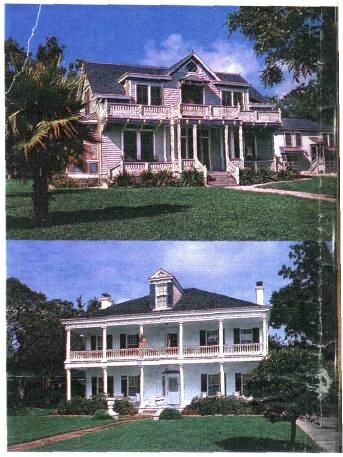 Victoria, once rumored to have the highest number of millionaires per capita in the state, boasts a wealth of magnificent old homes. Many of them, including the 1851 Phillips-Sale House (above), are listed in the National Register of Historic Places. Originally built in Indianola in the 1850s, the Huck-Welder House (top) was reassembled in Victoria after the 1886 hurricane. (webmaster note- David Clifton is a former owner of the Huck-Welder House) VPI makes it easy to view those National Register treasures. Special green-and-white street signs identify the 256 blocks in the "Old Victoria Original Townsite" platted in 1839, after Victoria became the third town to receive a charter from the Republic of Texas. Directional signs, in both the original town site and an adjacent historic addition, guide visitors on a historical driving/walking tour. The tour begins on La Calk de los Diez Amigos, the Street of Ten Friends. Also known as Main Street, the thoroughfare was named for Victoria's founder, Mexican colonizer and rancher Don Martin De Leon, and nine of his colony's early citizens, who helped the empresario govern the settlement. A native of Burgos in Nuevo Santander (now the Mexican state of Tamaulipas), De Leon decided to settle north of the Rio Grande after visiting La Bahia, San Antonio, and Nacogdoches in 1805. Though he established two ranches on Texas' coastal plains and became one of the earliest trail drivers by driving herds to New Orleans, Spanish authorities denied him permission to start a colony. In 1824, three years after Mexico won its independence, the provincial government at San Antonio approved his request to settle 41 Mexican families on the lower Guadalupe River. 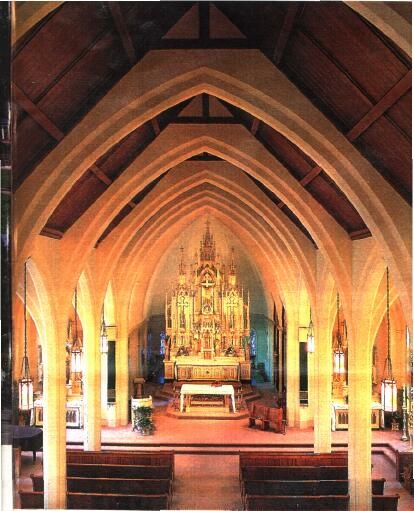 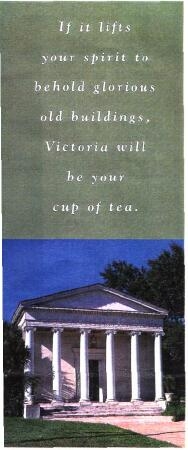 St Mary's Catholic Church (left) evolved from Our Lady of Guadatupe Catholic Church, the first church in Victoria. The latest structure, built in 1904, still serves parishioners. The Nave Museum (above) showcases changing art exhibitions. Though a number of Anglos also joined, the De Leon settlement was the only colony in Texas with a Hispanic majority. The village that became its social and trading center was named Nuestra Senora de Guadalupe de Jesus Victoria. Called Guadalupe Victoria, the community's name was shortened to Victoria after Texas won its independence. But when James Kerr surveyed the town as an expanded version of De Leon's village, he adhered to the town site plan of an 1827 Mexican colonization statute. Based on the 1573 Spanish Colonial Laws of the Indies, the plan called for a main plaza in the center of town, augmented by a market square and surrounded by an orderly grid of streets. Victoria's main plaza, first known as Constitution Square and later as Public Square, was renamed De Leon Plaza in 1941. It still occupies the center of the 256 blocks surveyed by Kerr in the late 1830s. A 1985 study by a California architecture and urban conservation firm concluded that "Victoria's town plan is an important surviving example of the Spanish legacy in America's urban settlements." 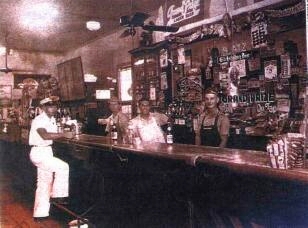 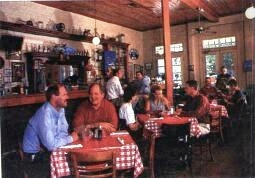 Fossati's, the oldest delicatessen in Texas, was already more than a half-century old when the photo on the left was taken (In the 1940s). Frank Napoleon Fossati, the current owner's great-great-grandfather, opened his saloon and deli In 1882. Now as then, Fossati's (above) offers delicious food in a lively setting. The restaurant opens for lunch on weekdays.  At today's DeLeon Plaza-the first stop on the VPI tour-stately pecan trees shade inviting benches. On occasion, musicians fill the 19th-century bandstand. A statue of a Confederate soldier, sculpted by Pompeo Coppini in 1912, stands watch here, while the six flags of Texas wave in the breeze. The French standard flaps in the vanguard. "We place the French flag before the Spanish because of Fort St Louis, which was established in present Victoria County by La Salle in 1685," explains Henry Wolff Jr., a longtime Victoria Advocate columnist The short-lived fort, from which the Texas Historical Commission recently recovered eight cannons, was the first European settlement in Texas, if you don't count Ysleta near El Paso. (Founded by the Spanish in 1681, Ysleta lay south of the Rio Grande until the river shifted course in 1829.) The brief French incursion here prompted the Spaniards to found military and spiritual outposts north of the Rio Grande. In 1721, Spain established Nuestra Senora de Loreto Presidio (Presidio La Bahia) at the ruins of Fort St Louis. Mission Nuestra Senora del Espiritu Santo de Zuniga was built across from the presidio on Garcitas Creek the following year. Later, the mission was twice relocated-in 1725, to the Guadalupe River, and in 1726, to near present Mission Valley, just north of Victoria The presidio was relocated between the two sites in 1726. Both mission and presidio moved to Goliad in 1749. Continuing south on La Calle, de los Diez Amigos, the VPI tour stops at Fossati's, the "oldest delicatessen in Texas." Italian immigrant Frank N. Fossati opened his saloon and deli in 1882, but the current building, operated by Fossati descendants and filled with historic photos and mementos, is a spry 104. Across the street from the deli lies the old market square, now home to Victoria City Hall. Just south of the square rise the twin steeples of St. Mary's Catholic Church. The latest incarnation of the church is a 1904 Gothic Revival beauty. Next door stands the Old Nazareth Academy, of 1906 vintage. The highly regarded Victoria architect Jules Leffland designed the edifice in an intriguing French-Alsatian style. Leffland had emigrated from Denmark in 1886, lured to Texas by a rancher friend. Shortly after his arrival, Leffland helped salvage homes from the hurricane-ravaged port of Indianola and reconstruct them in Victoria and nearby Cuero. He designed public and private structures from Wharton to Kingsville, and many of his Victoria buildings still stand, including the architect's own 1900 home at 302 E. Convent Still a private home, it features a two-story, eight-bay, wraparound porch. Four blocks north of Old Nazareth Academy, on the west side of De Leon Plaza, the 1892 Victoria County courthouse stands like a great stone castle, surrounded by scaffolding at press time. Dozens of workers clamber about, gently infusing the grand old temple of justice with new life. Designed by J. Riely Gordon in the Romanesque Revival style, the civic gem almost suffered the wrecking ball after a new courthouse arose next door in 1967. But hundreds of townspeople signed a 13-foot-long petition and saved the landmark. Once it is fully gussied up, its duties will supplement those of its younger neighbor. 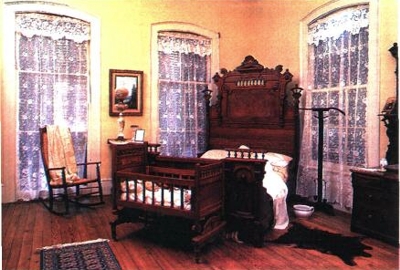 Once the home of prominent Victoria businessman W.J. McNamara, the McNamara House today operates as a historical museum. The furnishings reflect the lifestyle of a successful, but not extraordinarily affluent, family of the late 19th Century. The museum also features numerous photographs of old Victoria. Other private homes on the VPI tour include the 1851 Greek Revival Phillips-Sale House, where Sam Houston attended a ball after making a gubernatorial campaign speech across town in 1857. The 1855 Callender House, a Greek Revival "raised cottage," merits distinction as possibly the first house in Texas built of commercially milled lumber. (The pine and oak came to Texas all the way from New York.) While you can only see exteriors on most of the driving/walking tour, VPI sponsors a tour of historic homes each April that offers peeks inside some of these old-time domiciles (see When...Where... How, page 18). Visitors are welcome year round at the 1876 McNamara House. Restored and repainted in its original "natural tone" colors, the house-museum interprets late-19th-Century life with vintage furnishings and artifacts. A few blocks from the McNamara lies Memorial Square, another Victoria plaza, which served as the town's first public cemetery. Here, a mid-19th-Century gristmill and a steam locomotive stand among unmarked graves of soldiers from the Texas Revolution and the Civil War. Though the Guadalupe Victoria colony had a Hispanic majority, residents-including members of Martin De Leon's large family-supported the Texian revolt against Santa Anna and made many sacrifices for the cause. De Leon himself died of cholera in 1833 or 1834, and thus was spared the disappointment of seeing his town occupied by the Mexican troops that marched here after the fall of Goliad in 1836. After Texian forces defeated Santa Anna at the Battle of San Jacinto, newly arrived Anglos saw the Hispanic citizens of Victoria as Mexican loyalists and drove many of them out. The empresario's widow, Patricia de la Garza De Leon, and her family went to Louisiana and Mexico. Some family members later returned, and several generations of De Leon descendants still live in the area. Today, Victorians take pride in the fact that virtually every major ethnic group in Texas is found in their city. Charles Spurlin, director of local history at Victoria College and chairman of the Victoria County Historical Commission, says this cultural diversity has made Victoria the progressive town that it is.  nd progressive it is. On the VPI tour, you'll discover that the fine arts, as well as fine architecture, flourish here. The Nave Museum, another stop on the tour, presents changing exhibitions of contemporary and traditional art. The building, which resembles a Greek temple, was commissioned in the early 1930s by Emily McFaddin McCan Nave to house the work of her late husband, the Impressionist painter Royston Nave. A native of La Grange, Nave won acclaim in the New York art world of the 1910s, then returned to his home state in 1920 and painted in and around Victoria until his death in 1931. The museum's schedule includes an annual exhibition of Nave's portraits and Texas landscapes. nd progressive it is. On the VPI tour, you'll discover that the fine arts, as well as fine architecture, flourish here. The Nave Museum, another stop on the tour, presents changing exhibitions of contemporary and traditional art. The building, which resembles a Greek temple, was commissioned in the early 1930s by Emily McFaddin McCan Nave to house the work of her late husband, the Impressionist painter Royston Nave. A native of La Grange, Nave won acclaim in the New York art world of the 1910s, then returned to his home state in 1920 and painted in and around Victoria until his death in 1931. The museum's schedule includes an annual exhibition of Nave's portraits and Texas landscapes.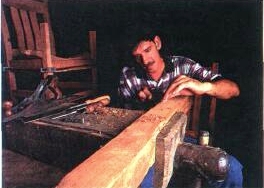 David E. Clifton, owner of the Texana Furniture Company, shapes a piece of salvaged longleaf pine. It will eventually become part of one of his hand-crafted, earty-Texas-style pieces. The chair in progress is a mesquite rocker. 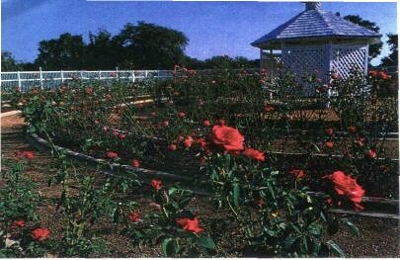 One of several attractions in Riverside Park, the Victoria Memorial Rose Garden offers fragrant tributes to beloved relatives and friends and a quiet place to enjoy nature's beauty. The garden, which displays more than 100 varieties of roses, blooms February through November, with peak viewing at Easter time. The Victoria Art League's Community Art Center, another stop on the VPI tour, showcases work by member artists in yet another historic structure. "Most Victorians still know the building as the Old Farmer's Co-op," says former Art League president Marie Frankson. Legend holds that businessman C.L. Thurmond modeled the 1898 brick building after a New Orleans bordello. When Victoria sculptor Harold Nichols bought the building in 1975, it had been vacant about 20 years. Harold renovated it and lived there until the Art League moved in. He now lives elsewhere on the property and hosts legendary parties and art events in the courtyard, where a life-size wood sculpture of Harold-carved by Harold-catches the eye. "If s from a huge oak tree that blew over in a storm," he explains. "Local folklore says it was a hanging tree." The artist attached a smaller mesquite carving of his parents on the sculpture's backside and named the piece Family Tree. Perhaps the most curious art project in Victoria (but unfortunately not open to the public) hangs in Henry J. Hauschild's home, the oldest house in town (the A.T. Sengele House, ca. 1844). Henry, whose business card identifies him as a "Physiognomist" "Bibliopolist," and "Cognoscente di Eccellentissimo," curates a "famous, unique, extraordinary 'Nose Gallery"' of paintings, photos, and sculptures of large or unusual nasal nozzles. He assembled the private collection "from 58 foreign countries." Henry says his study of human nature has led him to conclude that "a long nose and a good head are inseparable." Next door to the Nose Gallery stands the 1893 Hauschild Opera House, built by Henry's grandfather. Though the theater area of the opera house sits empty today, a photo display in the bookstore that occupies the front end of the building chronicles the opera house's history. Another historic entertainment parlor here still enchants audiences. Formerly the Electra Theater, this 1910 building now hosts live performances as Theatre Victoria. "We do everything from the classics to musicals and contemporary works," says Victoria Community Theatre executive director Roger H. Thomas. "Next year, well begin transforming the long-vacant Dunlap's Department Store on Main into our new, 475-seat home." The new facility will also host the Victoria Ballet Theatre. The Victoria Symphony, which just celebrated its 25th season, performs in the Victoria College auditorium. The Victoria Bach Festival will mark its silver anniversary next year. Directed by nationally acclaimed conductor Craig H. Johnson, the festival presents the baroque sounds of Bach as well as modern compositions. National Public Radio, which has broadcast some of the performances, calls the festival "a Texas treasure." Another art event that brings national attention to Victoria, The Fabric of Our Cultures, takes place each year on the second weekend in September. The juried show spotlights quilting, wearable art, weaving, knitting, needlepoint, hooked rugs, and fine hand-stitchery, among other things. Last year, entries came from 20 states and 127 Texas towns. 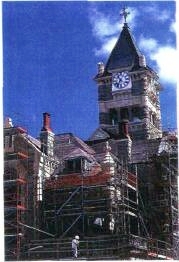 The scaffolding around the 1892 Victoria County courthouse will come down soon, signaling the imminent completion of an extensive restoration. Artwork with a functional dimension also characterizes David E. Clifton's Texana Furniture Company. David, who turns out about 150 handmade pieces a year, uses salvaged vintage hardwoods, such as cypress and longleaf pine, to create furniture in early-Texas style. Some of the company's cypress benches recently went to the Alamo. Most of the wood comes from folks dismantling old buildings. "Even though it's hard to lose historic structures," says David, "we feel like we're keeping the history alive by recycling the wood into early-Texas-style furniture." 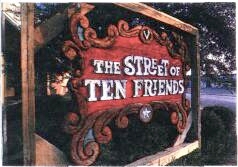 Carved by artist Tom Jones, the sign designating La Calle de los Diez Amigos (also known as Main Street) reflects Victoria's beginnings in 1824.  s much as Victorians appreciate the works of man, they honor nature's creations, too. Riverside Park, a 560-acre greenbelt, runs alongside several miles of the Guadalupe River. Within the park, the Victoria Memorial Rose Garden offers some 100 varieties of roses on more than a thousand bushes. In the 1880s, the many gardens in town earned Victoria the nickname "City of Roses." A short distance down Vine Street, still more roses bloom at the Victoria Botanical Garden. On the grounds, the 1870 Hiller House has been restored as an education and information center. Besides the roses, the 10-acre site includes herb gardens, a composting exhibit, beehives, a "native-scaping" area, and gardens designed to attract butterflies and hummingbirds. s much as Victorians appreciate the works of man, they honor nature's creations, too. Riverside Park, a 560-acre greenbelt, runs alongside several miles of the Guadalupe River. Within the park, the Victoria Memorial Rose Garden offers some 100 varieties of roses on more than a thousand bushes. In the 1880s, the many gardens in town earned Victoria the nickname "City of Roses." A short distance down Vine Street, still more roses bloom at the Victoria Botanical Garden. On the grounds, the 1870 Hiller House has been restored as an education and information center. Besides the roses, the 10-acre site includes herb gardens, a composting exhibit, beehives, a "native-scaping" area, and gardens designed to attract butterflies and hummingbirds.Even wilder wildlife thrives at The Texas Zoo in Riverside Park. "The state legislature named us the National Zoo of Texas in 1984," says education curator Debra Chronister, "because we exhibit more than 60 species of animals native to the state." Visitors can see all sorts of Texas critters here: badgers, bobcats, rare red wolves, bald eagles, white-nosed coatis, rattlesnakes, and roseate spoonbills. When last October's record flood inundated the zoo, about 90 animals, mostly snakes, were lost, but heroic efforts by the small staff and volunteers saved many. Closed briefly for repairs, the zoo reopened in the spring. The Texas Zoo sponsors the South Texas Beautiful Burro Pageant, which heehaws forth on the second Saturday of September. Initiated in 1983 by Henry Wolff Jr. (founder of the Better Burro Bureau), the pageant usually sports about 20 entrants. "We have categories like most obstinate, most congenial, and best-dressed burro," says Henry. "Winners receive trophies and 100 pounds of feed." Horses, bulls, and calves grab the spotlight at rodeos held each January and February. March brings an annual parade, the kickoff event for the Victoria County livestock Show, both sponsored by the Victoria Jaycees. Henry describes the show as "one of the state's largest county livestock shows." That's only fitting for a region many regard as the "Cradle of the Cattle Industry." In fact, Martin De Leon brought his brand with him when he came to Victoria, an E and J connected, which signified "Espiritu de Jesus." And the De Leon legacy has been continued by such ranching families as the McFaddins, OConnors, Keerans, Koontzes, and Welders. The Victoria area, writes historian Robert W. Shook, "justly claims some of the earliest herds, brands, and breeders, as well as the birthplace of the first managed herds to go up the trail following the Civil War." Henry Wolff Jr. points out that the large herds of "the first great cattle ranch in Texas" were maintained even earlier by Mission Espiritu Santo-when it was on the Guadalupe River, between 1725 and 1749-and he adds that the coastal plains cattle culture spurred the evolution of that storied breed, the Texas Longhorn. 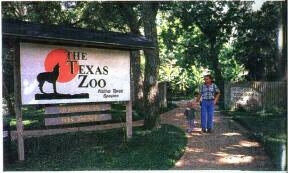 Visitors to The Texas Zoo can see more than 60 species native to the state. The menagerie Includes everything from bald eagles to bobcats.  ictoria hosts more than a dozen major annual events, but this year, townsfolk have been even busier than usual, celebrating the city's 175th birth day. The largest event, the first Victoria County Heritage Festival, is set for October 16. ictoria hosts more than a dozen major annual events, but this year, townsfolk have been even busier than usual, celebrating the city's 175th birth day. The largest event, the first Victoria County Heritage Festival, is set for October 16."We expect to have local, state, and international dignitaries on hand," says festival coordinator Patsy Hand. "One of the highlights of the festival will be a four-tier, 12-foot-high birthday cake, complete with 175 electric lights (representing candles). That cake will be wooden," explains Patsy, "but after the close of the opening ceremonies, two descendants of Martin De Leon will cut a real cake with the founder's sword." Patsy notes that the lineup also includes music and food all day long from the various ethnic groups representing Victoria's past and present The Texas Historical Commission, which will have a booth, will present a first-time-ever exhibit of small artifacts (ceramic fragments, nails, musket balls, animal bones, and other items) from Fort St Louis. (THC will begin major excavations of the site in January.) Living history re-enactors will demonstrate crafts like spinning and soap-making. Children can practice stilt-walking, throw washers, and play other old-time games. Genealogy buffs can research their family names, and an Author's Corral at the fest will offer book signings by area writers. At dusk, Henry Wolff Jr. and his wife, Linda, will lead a lantern-lit tour of historic Evergreen Cemetery, where the Heritage Festival will come full circle at the resting place of many of Martin De Leon's descendants. If the spirit be willing, perhaps the founder of Nuestra Senora de Guadalupe de Jesus Victoria will wish a Happy Birthday to each and every celebrant Here's to the next 175. ˇViva Victoria! * Austin writer GENE FOWLER attended a literary festival at the Victoria Public Library in the early 1980s and always remembered the city as an intriguing place. He has enjoyed learning more about its history. A first-time visitor to Victoria this past summer, staff photographer MICHAEL AMADOR was impressed with the city's many historic buildings. 
Many early Victorians chose Evergreen Cemetery (at the intersection of Vine and Red River Streets) as their final place of rest. Let's stroll among those chiseled stones and listen to a couple of their stories... The Poet Born in Victoria, Victor Marion Rose (1842-1893) left town for Laredo in the early 1880s, with rumors of a scandalous love affair blazing at his heels. But his troubles began much earlier. Wounded, imprisoned, and nearly starved to death during the Civil War, Rose had returned home to Victoria and a different way of life, with Reconstruction forces occupying the town. In 1867, his young wife died in a yellow fever epidemic, and Rose himself barely survived the malady. That same year, Reconstruction forces confiscated the family plantation, Forest Grove. Still, Rose rallied to become co-editor of the Victoria Advocate from 1869 to 1873. After his move to Laredo, Rose edited the Laredo Times and published several books of poetry: Los Despenadores, A Spanish Story; Demara, the Comanche Queen and Other Rhymes; and Celeste Valcoeur: A Legend of Dixie. Along with Elizabeth McAnulty Owens, whose memoir of Texas' revolutionary and republic eras was published posthumously in 1936, and John J. Linn (see When.. .Where... How), Rose became one of the first of Victoria's historians. His 1883 book, Some Historical Facts in Regard to the Settlement of Victoria, Texas, was placed in the cornerstone of the Victoria County courthouse in 1892. Lone Star Ma On the stump for governor in 1857, Sam Houston told Victorians that the "Mother of Texas" lived among them. While the town had been occupied by the Mexican Army during the revolution, Margaret Wright (1789-1878) hid, nursed, fed, and even stole a gun for Texans wounded at the Battle of Goliad. Margaret had already been widowed twice when she came to Texas from New Orleans in the 1820s. She settled as a colonist in Mission Valley, about 10 miles north of Victoria In an era when women's legal rights were limited, she fended off attempts by a mostly-absent third husband to seize her land grant (the husband was hiding out in the Rio Grande Valley from Mississippi debt collectors). Margaret raised cattle under her CT brand, which she registered in 1838. After Peter Hays, her son from an earlier marriage, was killed on the border, Margaret filed for divorce. Alleging murder (her husband had killed her son, she said), cruelty, and title fraud, she took her case to the Texas Supreme Court Some historians believe that the legal split granted Margaret Wright may have been the first divorce in Texas. -Gene Fowler  Victoria is at the juncture of US87, 77, and 59, about 115 miles southeast of San Antonio. For a free visitor's guide, write to the Victoria Convention & Visitors Bureau, Box 2465, Victoria 77902 361/573-5277 or 800/926-5774 Web site: www.visitvictoriatexas.com Victoria's area code is 361. All sites wheelchair accessible unless otherwise noted. Victoria Preservation, Inc., at 607 N. Bridge St, offers a brochure ($1) detailing a walking/ driving historic tour of the city. VPI also arranges guided tours of other historic residences for groups of 10 or more. Cost $15 per person. Write to Box 1486, Victoria 77902 361/573-1878 Web site: www.vpitx.com Heritage Festival To celebrate the city's 175th birthday, the Victoria County Historical Commission will host the first Victoria County Heritage Festival on Oct 16 at the Victoria Community Center at 2905 E. North St To reach the Community Center from downtown, go north on Bus. US 59, turn right on Ben Wilson St, and drive about a mile to North St The Community Center is on the right Hours: 11-8 (opening ceremonies at 10-30). Admission: $3, $1 ages 5-11, free age 4 and younger. 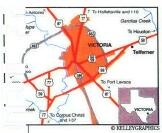 A tour of Victoria's historic Evergreen Cemetery (at the corner of Vine and Red River streets) concludes the event Admission: $5 (tickets and directions available at the Victoria C&VB and at the festival). The tour is not wheel-chair accessible. For details, write to festival coordinator Patsy Hand, 417 Cottonwood, Victoria 77904. 361/573-5277 or 800/926-5774. Other Events Remaining events celebrating Victoria's 175th birthday include an Old-Fashioned Beard-Growing Contest (registration Oct 1-8), the annual Holiday Lights at Night Parade (Dec. 3), and the Beard Ban (Dec. 10). A 175th-anniversary cookbook with recipes from area cooks will be released in mid-Nov. A New Year's Eve celebration at De Leon Plaza will include the burial of a time capsule. Call 361/572-2767 or 361/578-8867 for details. The 15th annual Victoria Czech Heritage Festival will take place on Oct 17 at the Victoria Community Center. Hours: 10:30-7:30. Admission: $5, free age 14 and younger. Call 575-4820. The Reunion of the Wings, a gathering of U.S. Air Force personnel who were stationed at Foster Field, Aloe Field, and the Matagorda Island Bombing and Gunnery Range (all closed now) in the 1940s and 1950s, will be held Oct 22-24. A barbecue dinner, a "USO-tour" show, and a Big Band dance will be open to the public. Air Show '99 will also be held on Oct 24. Cafl Victoria CVB for details. VPI's annual Tour of Historic Structures takes place each April (April 15-16,2000). Cost $12 per person ($10 if purchased in advance). Wheelchair accessibility varies. Contact VPI for details. The Victoria Bach Festival will celebrate its 25th anniversary Jut 31-Aug. 5,2000. For details, write to Box 3522, Victoria 77903; 572-2787. The Cultural Council of Victoria presents The Fabric of Our Cultures, a juried art show, the second weekend of each Sep. (Sep. 8-10,2000) at the Victoria Community Center. Hours: Fri-Sat 10-6, Sun noon-5. Admission: $4. Write to the Cultural Council of Victoria, Box 1758, Victoria 77902; 572-2787. Web site: www.ccvtx.org. For information on performances of the Victoria Community Theatre, write to Box 1365, Victoria 77902; 5766277 or 800/677-5696. For information on Victoria Ballet Theatre performances, write to 2508 E. Mockingbird, Victoria 77904; 575-2313. For information on Victoria Symphony performances, write to 2112 N. Navarro, 77901; 576-4500. Web site: www.icsi.net/ -symphony. Victoria boasts a host of other annual events and activities. For a complete listing, contact Victoria CVB. Attractions The McNamara House is at 502 N. Liberty (77901). Hours: Tue-Sun 1-5. Admission: $2, $1 age 12 and younger, free to members of Victoria Regional Museum Assn. Wheelchair accessible, but call ahead for details. Call 575-8227. The Nave Museum is at 306 W. Commercial Hours: Tue-Sun 1-5. Admission: $2, $1 age 12 and younger. Write to the Victoria Regional Museum Assn., 502 N. Liberty, Victoria 77901; 575-8227. The Victoria Art League's Community Art Center, in the Old Farmer's Co-op, is at 905 S. Bridge. Hours: Tue-Wed and Fri-Sat 10-2:30, Thu 1230-5. Admission: Free. Wheelchair accessible, but call ahead for details. Write to Box 5011, Victoria 77903; 572-0825. Texana Furniture Company is at 103 W. Santa Rosa (77901). Hours: Usually Mon-Fri 8-5. (The owner, David Clifton, welcomes visitors but suggests they call ahead; 578-1623). The Victoria Memorial Rose Garden is at 476 McCright Dr. in Riverside Park Hours: Daily 6 a.m.-ll p.m. Admission: Free. For information about the garden or designating a memorial, write to the Victoria Parks and Recreation Dept, Box 1758, Victoria 77902-1758; 572-2767. The Victoria Botanical Garden is at 3003 N. Vine (77901). Hours: Daily 6 anvil p.m. Tours by appt only. Admission: Free. Call 572-2767. The Texas Zoo is in Riverside Park at 110 Memorial Dr. (77901). Hours: Daily 9-5. Admission: $2.50, $2 age 65 and older, $1.50 ages 3-12, free age 2 and younger. Call 573-7681. Web site: www. viptx.net/texaszoo. Lodging Victoria has many modern motels. Historic accommodations include the following: Friendly Oaks, a B&B at 210 E. Juan linn St Call 5754000. Web site: www.bbhostcom:8008/ friendlyoaks. Forrest Place Suites, 507 West Forrest Not wheelchair accessible. Call 578-4260 or 888/ 578-4260. Web site: www.forrest place.com. The Inn on Main, 315 N. Main. Not wheelchair accessible. Call 580-2794. Restaurants Fossati's, "the oldest delicatessen in Texas," is at 302 S. Main (77901). Hours: Mon-Fri 11-2:30 (open on weekends only for private parties). Call 576-3354. Other Victoria restaurants include Siesta (Mexican, 578-9927), Maggie's Meat Market and Restaurant (American, seafood, and steaks, 573-0428), Trevino's El Toro (Mexican, 575-8992), Taqueria Victoria (Mexican and Italian, 572-8226), The Kettle Inn-Las Cazuelas (Mexican, seafood, and steaks, 578-3021), Olde Victoria Restaurant (Italian, steaks, and seafood, 572-8840),The Lost Cajun (573-5751), Dragon Palace (Chinese, 573-1342), PJ's Seafood (578-7302), and The Corral (steaks, seafood, and barbecue, 576-1277). Resources Look in your local library or bookstore for the following books: Reminiscences of Fifty Years in Texas by John J. Linn (Victoria's first mayor), an 1883 book reprinted in 1986 by State House Press; The Handbook of Victoria County (Texas State Historical Assn., 1990); Our Part of Texas: Faces and Places by Catherine McHaney and Charles D. Spurlin (D-Books Publishing, Inc., 1996); and The Great Comanche Raid: Boldest Indian Attack of the Texas Republic by Donaly Brice (Eakin Press, 1987). Victoria Advocate columnist Henry Wolff Jr. recently published Ghosts ofGoliad and Other Stories of Presidio La Bahia. For ordering information about it or his previous books, write to Henry's Journal, Box 1518, Victoria 77902; 575-3689. Email:wolfhaus@txcr.net Many of the books listed can be purchased through the Victoria College bookstore. Write to 2200 N. Ben Jordan, Victoria. 573-3291. Also, the Victoria College/University of Houston-Victoria Library contains an excellent selection of Victoria-related materials. |
| Home | About Us | Products | Services | Contact Us Copyright © 2010 Texana Furniture Co., Inc. |